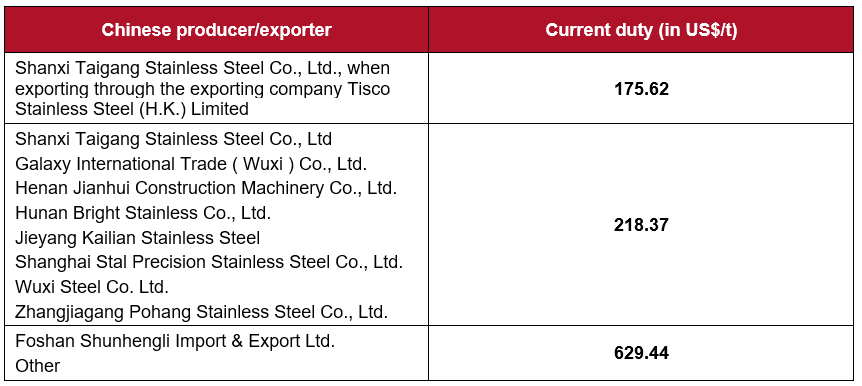Anti-circumvention review launched on antidumping duty in force against Brazilian imports of cold rolled steel from China
In brief
On 27 October, 2023, SECEX launched an anti-circumvention review to investigate the existence of trade practices that frustrate the application of the antidumping duty in force against Brazilian imports of cold rolled stainless steel (types 304 and 430) from China. The SECEX Circular that launched the investigation is available at this link.
According to the petitioner (the Brazilian producer Aperam), Chinese producers and exporters are substituting their exports of steel of the types 304 and 430 (which are subject to the antidumping duty) for exports of steel of the 2xx series and of the type AISI 410, respectively. As a result, the antidumping duty in force would no longer be effective to neutralize the damage to the domestic industry.
At the end of the investigation, SECEX may expand the scope of the antidumping measure to include the products that are alleged to be frustrating its objective.
Importance of the participation of interested third parties
Any interested parties may participate in the investigation, contributing with elements to secure a more favorable outcome. According to the opening Circular, the authority will only send questionnaires to producers/exporters. However, this does not prevent importers from actively participating, being that companies that do not automatically qualify as an interested third party (such as importers of the product under review) have a 20-day deadline to request their qualification in the proceeding (until 21 November, 2023).
More details
The existing antidumping duty against Brazilian imports of cold-rolled steel from China was originally established by CAMEX Resolution No. 79 of October 3, 2013, and extended by SECINT Ordinance No. 4,353 of October 1, 2019.
In more detail, the product covered by the measure was defined as “flat products of austenitic stainless steel type 304 (304, 304L and 304H) and ferritic stainless steel type 430, cold-rolled, with a thickness equal to or greater than 0.35 mm but less than 4.75 mm“.
Its main uses are as follows:
- Type 304 cold rolled steel is used in the manufacture of towers, tubes, tanks, general, deep and precision stamping, with diverse applications such as household utensils, cryogenic installations, distilleries, photography, as well as in the aeronautical, railway, shipbuilding, petrochemical, pulp and paper, textile, refrigeration, hospital, food, dairy, pharmaceutical, cosmetics and chemical industries, among others.
- Type 430 cold rolled steel is used in a variety of applications, such as cutlery, tableware, kitchen sinks, stoves, washing machine tanks, dishwashers and microwave ovens, coin minting, among others. This type of steel is also used in counter coverings and telephone cabinets
According to the domestic producer, the stainless steel of the 2xx series and of the AISI 410 type that Chinese producers and exporters began to export to Brazil are products with only marginal modifications in relation to the product subject to the antidumping measure, which do not alter their use or final destination, and therefore fall within the hypothesis of circumvention provided for in Article 121, III, of the Brazilian Antidumping Decree.
Due to the alleged circumvention, the domestic producer requests an extension of the scope of the current antidumping measure, so that it also covers stainless steels of the 2xx series and of the AISI 410 type.
For reference, the antidumping rates currently applied on Brazilian imports of cold rolled steel (types 304 and 430) from China are listed below:



